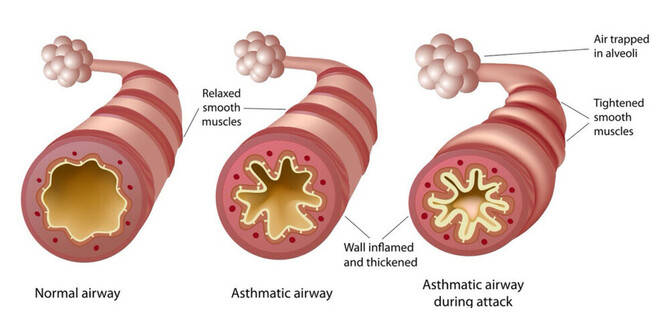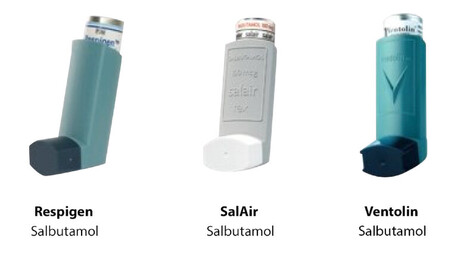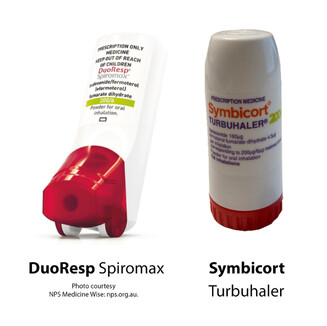Are you/your child (12+ years) using just a blue reliever puffer, but no regular preventer? It’s ok, you aren’t alone – PLEASE read on. There’s a new regime now and you need to know about this.
The Short Version
The preferred regime for ALL those aged 12+ years is to use a Budesonide/Formoterol inhaler (Symbicort or DuoResp (18+)) as a reliever instead of the blue puffer. Symbicort or DuoResp can also be used as a preventer either once or twice a day if needed, with the dose and frequency specified by your GP, as well as a reliever for symptoms as required.
However, if somebody is well controlled on their current regime and they are using a daily preventer in the correct way, with correct technique and correct dose etc and not requiring their blue puffer more than twice a week, then there would be no point changing that. They can remain as they are.
Those that are purely reliant on a blue puffer only should absolutely be switched to the new regime. Once Symbicort/DuoResp is being used as a reliever, then there would be no indication to also prescribe a blue puffer to that person as well.
In 2019/2020 there were major changes to the global guidelines in regards to asthma management. In 2020, The Asthma and Respiratory Foundation of NZ released the new NZ guidelines, again with significant changes.
Before we can describe this new regime in a way you’ll understand, here’s the background information, so you fully grasp why things were changed.
The Glitch
Asthmatics unfortunately have a little ‘glitch’ in their wiring. We all have glitches of some sort though, and they all have different names. The person who can’t tolerate gluten has a glitch – it’s called coeliac disease. The person with leaky skin has a glitch – it’s called eczema. The person with over-sensitive airways that over-react to normal things in the air also has a glitch - it’s called asthma.
This Glitch Results In Two Problems
- The muscles around the outside of the airways throughout the lungs contract, squeezing the airways, resulting in shortness of breath, cough, wheeze and tightness in the chest.
- Inflammation develops on the inside of the airways – swelling, mucus and redness/irritation, gumming up and blocking the airway.
- Two problems = it’s hard to breathe.
- Two problems = two medicines. These two medicines have very specific jobs. One can’t do the work of the other.
The Reliever ‘Blue’ Puffer
Salbutamol comes in three brands in NZ – Respigen, Ventolin and Salair (this last one is grey, not blue). The job of this puffer is to relax the muscles around the airways, which opens up the airways. It does a great job,it is a fantastic first-aid medicine that works very quickly but it is a real one trick pony. That’s all it does. It has no idea how to treat the inflammation on the inside of the airways. It only knows how to relax the squeezing muscles.
The Preventer Puffer
Preventers treat the inflammation on the inside of the airways. They clear it out, and over time the airway will then be less sensitive to triggers. They come in many forms. These medicines are usually 12 hour medicines which mean they have to be given twice a day every day, even when you are well to be effective. To even miss three doses a week can result in less effectiveness.
The Problem
In the past, the old ‘step’ one’ of asthma treatment in adolescents and adults was that at the very least they would have a Salbutamol reliever, or blue puffer. Most asthmatics would use this for symptoms and most would be pretty slack about using a spacer (spacers are recommended for all puffer-type aerosol inhalers). They’d also be pretty slack about remembering to take a preventer twice a day, because let’s face it:
- It is hard to remember to take a twice daily medicine
- Asthma is a long-term, annoying, boring condition to contend with and many mild asthmatics are in denial or think they have ‘outgrown it’
- Most mild asthmatics only have symptoms sporadically so would have no regular reminder of poor breathing to drive them towards a daily preventer
- You can’t ‘feel’ a preventer working straight away
- You can ‘feel’ a reliever working straight away.
- Too much reliever will eventually make the swelling and inflammation inside the airways worse.
- Too much reliever can actually result in the body just not listening to it anymore, meaning that when you need it to work in an emergency, it may not work, or it may not work so well
- Relying just on a reliever means that nothing is being done about the inflammation inside the airways. It’s great first aid, but in reality it’s like tying a bandage on a gunshot wound. It will save your life, but if that’s all you did for days on end, eventually the thing that saved your life on day one will be creating a major problem on day 7 if nothing is done about the problem underneath.
The Result
Asthmatics, particularly those with mild asthma, who were over-reliant on a reliever with no regular preventer, were dying.
The Solution
- DuoResp spiromax (currently registered and funded for 18+ year olds)
- Symbicort turbuhaler (registered and funded for 12+ year olds as a reliever and preventer)
Symbicort and DuoResp are combination inhalers – it’s a two-for deal. They contain both a preventer to treat the inflammation on the inside of the airways and also contain a reliever to tell the squeezing muscles to relax.
But there are other combination inhalers that do that already – so what is the difference?
The difference is that the medicines (Budesonide and Formoterol) in Symbicort and DuoRespwork very quickly - this means that they can be used as both a preventer and reliever. The other combination inhalers are too slow – they will not work quick enough to provide relief. Currently the only two funded Budesonide/Formoterol combination inhalers licensed for use as a reliever are Symbicort and DuoResp.
The Old Way Of Doing Things
So, let’s say your asthma symptoms are brewing (you haven’t been taking your preventer as you should). In the past you would have reached for your blue puffer. You’d feel it working, but behind the scenes, the inflammation would be getting worse and worse, because the blue puffer doesn’t treat that. The worse the inflammation gets, the more you need your blue puffer. And so you take more. And more. And more.
Eventually, the airway is so gummed up with inflammation and mucus that even when you reach for the blue puffer and relax the muscles again, you still can’t breathe through all the inflammation inside the airways, and you end up in hospital. By this point, you have flooded your body with so much blue puffer that it may or may not even work anymore. You’ll need oral steroids – which have strong unwanted side effects. You may end up in ICU. You may have a lengthy hospital stay. You may not even get to leave the hospital.
The New Way Of Doing Things
Your asthma is brewing. Instead of reaching for the blue puffer you reach for Symbicort or DuoResp. You get the relief you were looking for, but as an added bonus, you get some medicine to treat the inflammation. The more of the Symbicort/DuoResp you take, the less inflammation you’ll have in your airways, and so the whole situation gets turned around and resolved quicker, with less medicine and no severe flare-up.
Basically, the new regime works with you, rather than against you.- It works with your forgetfulness, rather than against it, because if you forget a dose, your body will give you symptoms, and you’ll reach for the new inhaler and you’ll not only get the treatment you need, you’ll also get the dose you missed anyway.
- It works with your dislike for a spacer as the new regime is dry powder and doesn’tneed a spacer.
- It works with your preference to act on symptoms alone.
Who Should Be Switched To The New Regime?
The preferred regime for ALL those aged 12+ years is to use a Budesonide / Formoterol inhaler (Symbicort or DuoResp (18+)) as a reliever instead of the blue puffer. Symbicort or DuoResp can also be used as a preventer either once or twice a day if needed, with the dose and frequency specified by your GP.
However, if somebody is well controlled on their current regime and they are using a daily preventer in the correct way, with correct technique and correct dose etc and not requiring their blue puffer more than twice a week, then there would be no point changing that. They can remain as they are.
Those that are purely reliant on a blue puffer only should absolutely be switched to the new regime. Once Symbicort / DuoResp is being used as a reliever, then there would be no indication to also prescribe a blue puffer to that person as well.
There are different ways in which the new regime can be used, depending on the person’s frequency of symptoms, presentation and severity of illness. Some may be able to use it purely for symptoms only; others may need a daily or twice daily dose as well as using it as a reliever.
The goal is to find the point of ‘least amount of medicine, best result’ and to ultimately require reliever therapy less than twice a week. Because believe it or not, when asthma is well controlled and well managed, there should be virtually no symptoms and no limitation on life. Correct preventer therapy, either using the old way or switching to the new, basically corrects the ‘glitch’. This new regime is a great step forward in ensuring the safety of asthmatics and giving them a new lease on life. Glitch-free.



